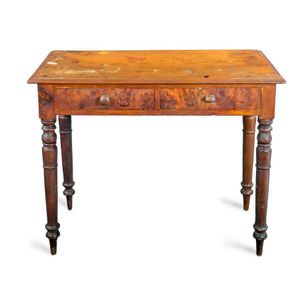Dutch Bureau de Dame with Leather Inset Top and Drawers
You must be a subscriber, and be logged in to view price and dealer details.
Subscribe Now to view actual auction price for this item
When you subscribe, you have the option of setting the currency in which to display prices to $Au, $US, $NZ or Stg.
- Stretcher - A horizontal rail which connects the legs of stools, chairs, tables and stands, to provide stabilisation of the legs. A stretcher table is any table with a stretcher base. The term is usually applied to substantial farmhouse tables, although many cabinetmaker's pieces, such as sofa tables, also have turned stretchers.
- Turning - Any part of a piece of furniture that has been turned and shaped with chisels on a lathe. Turned sections include legs, columns, feet, finials, pedestals, stretchers, spindles etc. There have been many varieties and fashions over the centuries: baluster, melon, barley-sugar, bobbin, cotton-reel, rope-twist, and so on. Split turning implies a turned section that has been cut in half lengthwise and applied to a cabinet front as a false decorative support.
- Blind Tooling / Blind Tooled - Blind tooling is a technique used in the decoration of leather goods such as book covers, belts, and wallets. It involves the use of specialized tools to impress designs and patterns onto the surface of the leather without the use of added colour.
The process involves the use of a variety of tools, including stamps, embossing tools, and finishing tools, which are used to create various textures and patterns on the leather surface. The tools are heated, and then pressed onto the leather, leaving an impression. The tools can be used to create designs that are simple or complex, with a variety of textures and patterns, including geometric shapes, florals, or scenes. The leather is then burnished to enhance the design and give it a smooth finish. - Turned Legs - are legs which have been turned on a lathe. In use from the 16th century, turned legs on tables, chairs and cabinets became more frequent until, by the 1830s, the Georgian square or tapered leg was rarely found except in country pieces.
- Loop Handles. - Throughout the Georgian period, a form of loop handle was used on drawer fronts, where the pull was attached to a solid or pierced brass backplate, frequently shaped and scalloped. Keyhole escutcheons were often made in similar design. Towards the end of the 18th century, the backplate was often oval in shape and impressed with a variety of beads and patterns. Smaller loop or ring handles were made, with the circular brass backplate complementing the ring pull
This item has been included into following indexes:
-
desks, style or type
- bureau 374
- bureau de dame 21
- Dutch style 7
Visually similar items

A huon pine side table, Tasmanian, circa 1850, 73 cm high, 91 cm wide, 48 cm deep

An early Victorian mahogany partners desk rectangular, with a leather inset top and three frieze drawers to either side, raised on fluted supports, brass caps and castors, 152 x 77.5 x 89 cm

A French Louis XV style elm side table. Rectangular form with canted corners, below drawers flanked by corbels on cabriole legs with under shelf. 72 cm high, 52 cm wide, 35 cm deep

A George II oak two drawer side table rectangular, with three drawers, above slender cabriole legs with pad feet, numerous losses and overall heavy wear, 78.5 x 71.5 x 50.5 cm
